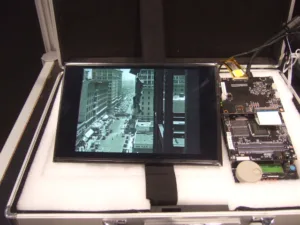2D to 3D Processing
At last year’s CES, the company talked about a new project to port its software to the Qualcomm 8074 Snapdragon processor. That process is now complete and the processor can be integrated into 4K displays to allow conversion of 2D content to the multi-view autostereoscopic Ultra-D format or conversion of stereoscopic content into the Ultra-D format – all in real time. (Which explains the presence of StreamTV on the Qualcomm booth at CES – Man. Ed.)
 The Ultra-D format consists of the 2D image plus a depth map plus metadata to help create the multi-view images and stitch them together into a single frame of video. The metadata also allows the end user to adjust the depth volume and the depth position relative to the screen plane. This IP can also be licensed for those who want to make their own ASIC or display SoC.
The Ultra-D format consists of the 2D image plus a depth map plus metadata to help create the multi-view images and stitch them together into a single frame of video. The metadata also allows the end user to adjust the depth volume and the depth position relative to the screen plane. This IP can also be licensed for those who want to make their own ASIC or display SoC.
The SeeCube processor can accept content from any source: Blu-ray, cable, satellite, X-Box, PlayStation, and OTT services such as Netflix.
In 2014, Ultra-D offered a 50” 4K panel from Innolux. In 2015, it will focus on a 65” 4K panel from AUO. To make a 3D display, StreamTV redesigned the optical layer to provide more depth and increased clarity. The company also set up a new 2000 sq. m. bonding facility in China. This should be ready to begin production in March with volumes of 50-100K expected for the first year.
Broadcast 3D Solution from Stream TVAfter bonding, the panel is then sent to a Pegatron factory in Taiwan where electronics and mechanical assembly is performed. The separate bonding facility was needed because the tact time was too long to fit into Pegatron factory flow.
In the TV segment, StreamTV now counts Cello Electronics, IZON, Hisense, BOE, Konka and Skyworth as customers.

